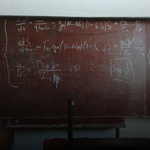Section 1
Preview this deck
∫acceleration
Front
Active users
0
All-time users
0
Favorites
0
Last updated
5 years ago
Date created
Mar 1, 2020
Cards (69)
Section 1
(50 cards)
∫acceleration
velocity
volume
∫area
cosx
-sinx
MVT
requirements: differentiable takes info about a function and gives back info about the derivative there is some "c" in the interval between a and b such that f(a)-f(b)/a-b =f'c
frq 6: diff eq's
given a diff eq, find the equation of the tangent line (derivative) at this point and then approximate this value using it. y-y1=m(x-x1) they gave you the point for the x1, y1 and just evaluate the diff eq at those points to get m. finding the particular solution separate the variables integrate to remove the dx, don't forget plus c then evaluate at the point they say it passes through (inish condish) to solve for c. now plug c back into the equation and clean up your answer for y= if the second derivative is positive that means theirs and upward concavity and so the tangent line is under the curve and an underapproximation.
midpoint approximation
subintervals are all of equal length ∑(subinterval length)(y value of the middle x value).. you may have to go hunt a little to find what the y value of the middle value is
inflection points
f'' changes sign
frq 4: slope fields and tables
slope fields are just taking the points and plugging them into the diff eq and then drawing their slope in. finding m and b for a solution to a diff eq? replace all the y's with "mx+b" and replace all dy/dx with "m" then even out the sides and compare what you would need for m to work. then solve for b.
lnx
1/x
IVT
requirements: continuous takes info about a function and gives back info on the SAME function on the interval [a,b], and m is some number between f(a) and f(b), then there exists a c between [a,b] such that f(c)=m
area of cross sections
top-bottom
sinx
cosx
frq 3: position/velocity or motion
|position|=distance |velocity|=speed position derivative is velocity particle is moving left when v(t) <0 and moving right when v(t)>0. particle speed is increasing when velocity and acceleration have the same sign and decreasing when they have opposite signs because physics. watch your units
continuity
lim x→a = f(a) point discontinuities are continuous as long as there isn't another dot filled in on the same x value jump discontinuity can you go along without picking up your pencil
related rates
define your variables and draw a picture describe your info with proper notation come up with an equation relating the variable you know and the one you want to come up with take derivative of each term implicitly (usually with respect to time) d/dt the whole equation! implicit is just regular differentiation just whenever you see a key variable then you add on. insert what you have and solve the problem with proper units
quotient rule
top derivative goes first when subtracting
cotx
-csc²x
tanx
sec²x
∫f+g
∫f + ∫g
limits
lim exists if limx→a+ =limx→a−
∫position
distance
∫ from 11 to 5
-∫ from 5 to 11
∫velocity
position
cscx
-cscxcotx
derivatives
create pers (forwards) but the expo will decrease
|velocity|
speed
right rieman sums
1/b-a ∑(subinterval length)(the left datapoint)..
new =
old+change
frq 1: rates
take stock: equation name, units, and possibly net rate function. make sure you know what units the derivative and integral will be in. make sure you catch when to use net equation, or use in outs with a < and > things. new= old + change (see if there was a certain amount in to begin with) finding a max or min, use extrema and critical values for suspects, but check it against the original equation!
approaching infinity n/p
if degrees are same then approaches the coeffs fraction if degree on top is greater than approaches +∞ if degree on bottom is greater than approaches 0
finding absolute max and min
suspects: critical values and endpoints. relative mins and maxs can be ruled out. check the suspects against the regular function (just f(x)) and the minimum will be the lowest of the values and the maximum will be the highest. if they ask for value then give the y if they ask where it occurs give the x
relative max where
f' goes from + to -
relative extrema occur where
f' changes sign
integrals
removes pers (backwards) but the expo will increase and then divide the whole term by the new expo just think what equation do you need who's derivative would give you what you have right now area under the curve +C
only use absolute value when
the ln was born out of an equation that didn't originally have an ln in it or if the problem makes it necessary
f is concave up
f'' is positive
EVT
requirements: continuous there must be a max and min on that interval
a∫b
F(b)-F(a)
secx
secxtanx
differentiable
continuous smooth no vertical tangent line derivatives on both side are equal
ex
ex
f is increasing
f' is positive
frq 5: max min graph derivatives
they'll give you a graph or an equation of some function. make sure you note the difference and similarities between the two. is one the derivative of the other or the integral, etc? regular derivative rules and increasing on what intervals. just manipulate variables to get in the context you want. remember the slope of the line is it's derivative or it's tangent.
1/b-a a∫b
average
f(a)-f(b) / a-b
average rate of change algebra average slope aroc approximate f'(x)
left rieman sums
1/b-a ∑(subinterval length)(the right datapoint)..
taylor polynomials
take the equation they give you and derive and solve with the given center for as many n's as you like: _ +_x +_x²/2! + _x³/3! + _x⁴/4!.... watch for patterns. your exponents and your denoms will match up, only your coefficients will vary
trapezoidal approximation
∑(subinterval length)(y value + y value/2) just like a trapezoid
critical values
f' = 0
frq 2: area volume or region bounded
label which curves are which equation area = ∫top curve-bottom curve, limits also in terms of x volume =∫area ex: square is bh or b² is ∫(top-bottom)² distance between curve= top-bottom, if you want the rate the distance changes then it's derivatives because they create pers. if there's a crazy one where there is no top and bottom, then you'll have to switch things to y terms; area =∫right-left and do it from y to the y where they intersect. or you can break it up individually, keep it in x terms but now divide the region by the intersection point and add the two all in x. use this method with the volume, you'll have to do the volume in both parts then. with circles rotated around some y= value. your doing cross sections, so it would π∫(R-r). draw the line and make a perpendicular dashed line hitting both parts of the curve.
Section 2
(19 cards)



